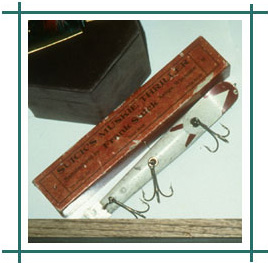 Weather
Sayings: Wind
from the West
Weather
Sayings: Wind
from the West
Wind from the West, fish bite the best.
Wind from the East, fish bite the least.
Wind from the North, do not go forth.
Wind from the South blows bait in their mouth.
|
Photo by Ruth Olson |
Introduction
This curriculum unit will allow your students to explore the folklore, language arts and meteorology behind the “Wind from the West…” proverb. Observations of the weather turn into predictions, which sometimes turn into proverbs. This lesson will explore the link between observation, prediction and proverbs.
Weather is a driving force everywhere. Weather and climate conditions affect all aspects of life on earth. We’re especially attuned to how daily and seasonal weather affects our crops, gardens, vacations, outdoor work, and road safety, to name a few.
As have people in other places and other times, we link our observations of weather with our experiences of it. This is the first step in learning to predict weather. By observing the sky and keeping track of what happened, people learned to associate particular cloud types with a high chance of rain. By observing certain plants, people could predict a change in the weather. By observing animal behaviors or appearance, people could predict temperature changes.
For many people, predicting the weather through observation has been a necessary part of life. Farmers, hunters, sailors and others who are most directly affected by weather use these observations to protect themselves and their livelihood from the elements. Today, few people in Wisconsin rely solely on prediction by observation. Radars and satellite data provide detailed information that professional forecasters interpret and deliver via print, radio, television and internet sources. Many non-professional weather buffs seek out the same data to interpret on their own.
Even with our access to sophisticated weather prediction techniques, most people still utilize informal understandings of the weather. We all inherit traditional lore that serve as tools for predicting local weather. Proverbs - short sayings that convey advice or beliefs - are one type of this lore. For example, “The higher the clouds, the better the weather” is an observation-based saying that works to predict the day’s weather.
Proverbs often use poetic devices in order to be easily remembered. Proverbs may or may not be rhymed; they are generally full of vivid imagery that adds to their memorability. “Rain before seven, clear by eleven” is a saying commonly heard in Wisconsin that is compelling not only because of its predictive worth but also because of its rhyme and meter.
Whether we realize it or not, proverbs are all around us. “Don’t count your chickens before they’re hatched” or “The early bird gets the worm” are familiar fixed sayings that give advice. Some proverbs can be seen as traditional solutions to traditional problems, such as “Make the best of a bad job.” Proverbs often present one point of view: “Look before you leap,” may contradict a different point of view expressed by, “He who hesitates is lost.”
Proverbs reflect the culture that they come from. For example, the Swahili proverb popular in eastern and central Africa, “Wapiganapo tembo nyasi huumia,” translated as, “When elephants fight, the grass gets hurt” reflects a universal truth but is expressed in culturally specific terms (elephants). Proverbs may dictate behavior appropriate to a cultural group or present social norms, as in “Children should be seen and not heard.” Proverbs can also be used as a sort of scapegoat; they can take away troublesome responsibility. For example, a poor day’s fishing can easily be explained by the wind direction, and not by one’s lack of fishing skills. Proverbs are a fascinating and intricate part of day-to-day life here in Wisconsin.
Focus Questions
What is a proverb? Why do individuals and communities use them?
How do proverbs as folklore forecasts fit with other types of forecasting methods?
Learning Objectives
Folklore
- To understand that weather lore is a part of everyday life.
- To understand that weather lore is linked to cultural communities.
Language Arts
- To understand what a proverb is.
- To build an appreciation for the narrative artistry of proverbs.
- To understand “variants” of proverbs.
Meteorology
- To understand the different types of predictive methods used in meteorology.
Preparing to Teach this Lesson
“Wind from the West” Proverb
Wind from the West, fish bite the best.
Wind from the East, fish bite the least.
Wind from the North, do not go forth.
Wind from the South blows bait in their mouth.
Weather is a driving force everywhere. Weather and climate conditions affect all aspects of life on earth. We’re especially attuned to how daily and seasonal weather affects our crops, gardens, vacations, outdoor work, and road safety, to name a few.
As have people in other places and other times, we link our observations of weather with our experiences of it. This is the first step in learning to predict weather. By observing the sky and keeping track of what happened, people learned to associate particular cloud types with a high chance of rain. By observing certain plants, people could predict a change in the weather. By observing animal behaviors or appearance, people could predict temperature changes.
For many people, predicting the weather through observation has been a necessary part of life. Farmers, hunters, sailors and others who are most directly affected by weather use these observations to protect themselves and their livelihood from the elements. Today, few people in Wisconsin rely solely on prediction by observation. Radars and satellite data provide detailed information that professional forecasters interpret and deliver via print, radio, television and internet sources. Many non-professional weather buffs seek out the same data to interpret on their own.
Even with our access to sophisticated weather prediction techniques, most people still utilize informal understandings of the weather. We all inherit traditional lore that serve as tools for predicting local weather. Proverbs - short sayings that convey advice or beliefs - are one type of this lore. For example, “The higher the clouds, the better the weather” is an observation-based saying that works to predict the day’s weather.
Proverbs often use poetic devices in order to be easily remembered. Proverbs may or may not be rhymed; they are generally full of vivid imagery that adds to their memorability. “Rain before seven, clear by eleven” is a saying commonly heard in Wisconsin that is compelling not only because of its predictive worth but also because of its rhyme and meter.
Whether we realize it or not, proverbs are all around us. “Don’t count your chickens before they’re hatched” or “The early bird gets the worm” are familiar fixed sayings that give advice. Some proverbs can be seen as traditional solutions to traditional problems, such as “Make the best of a bad job.” Proverbs often present one point of view; “Look before you leap” may contradict a different point of view expressed by, “He who hesitates is lost.”
Proverbs reflect the culture that they come from. For example, the Swahili proverb popular in eastern and central Africa, “Wapiganapo tembo nyasi huumia,” translated as, “When elephants fight, the grass gets hurt,” reflects a universal truth but is expressed in culturally specific terms. Proverbs may dictate behavior that's appropriate to a cultural group or present social norms, as in, “Children should be seen and not heard.” Proverbs can also be used as a sort of scapegoat; they can take away troublesome responsibility. For example, a poor day’s fishing can easily be explained by the wind direction, and not by one’s lack of fishing skills. Proverbs are a fascinating and intricate part of day-to-day life here in Wisconsin.
"
Wind from the West” Proverb
Wind from the West, fish bite the best.
Wind from the East, fish bite the least.
Wind from the North, do not go forth.
Wind from the South blows bait in their mouth.
Proverbs can tell us a lot about the people who say them. Proverbs act as tiny packages of community advice. In them one can read the value system of a community. We can learn more about a community’s work ethic, common occupations, and values by looking closely at proverbs.
Even though they originate in a specific local community, some proverbs contain universal truths and so resonate with people outside the originating community. These proverbs are mobile, and travel from place to place with the movement of people.
The “Wind from the West” proverb is an example of such a proverb. This saying was recorded as early as the 1600s in England, and can be heard today in 21st century Wisconsin. The proverb is memorable and snappy; it is practical and applicable to day-to-day life.
This proverb is clearly one that can be identified with fishing communities. The value with which Wisconsin holds its sport and commercial fishing economy makes it unsurprising that this old saying is found on the "new" continent. Immigrants, probably from England or Scotland, brought this saying to America and eventually Wisconsin, and because of the economy and environment, the saying stuck.
Those who fish, whether for profit, subsistence or recreation, hope for a successful day of fishing. The ability to accurately predict one’s day of fishing matters a lot to those who fish. Using wind direction to predict fishing is both successful and easy. This proverb makes this simple method easy to remember and to relate to others.
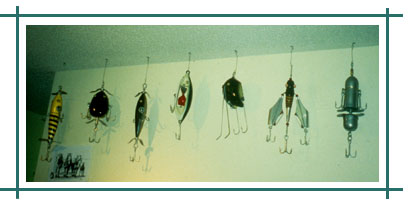 Large wooden lures made by Gil Miller of Appleton, WI, on display at the Northland Fishing Museum in Osseo, WI. Photo by Ruth Olson |
Analyzing the Proverb
There are many kinds of language arts, both contemporary or traditional in
origin: stories, song lyrics, novels and poems are just a few. One form of
the language arts which students may have considered is the proverb or folk
saying. Proverbs have many literary attributes; some rhyme, some have a regular
meter, some use imagery or alliteration.
(a) Wind from the West,
(a) Fish bite the best;
(b) Wind from the East,
(b) Fish bite the least;
(c) Wind from the North,
(c) Do not go forth;
(d) Wind from the South,
(d) Blows bait in their mouth.
This folk saying probably has its origins in the British Isles and may be five hundred years old or more. Even today, anglers use this saying to predict success for the day or to excuse a poor day of fishing.
“Wind from the West…” is a great example of folk language art. In this old saying you can see some of the most commonly used literary methods in a utilitarian setting. A poem in itself, the proverb makes good use of poetic techniques.
First, this proverb is very rhythmically appealing. In other words, it has a good beat. “Wind from the West, fish bite the best…” The pattern of accented syllables, or feet, is called dactylic tetrameter. A dactyl is an accented syllable followed by two unaccented syllables. The end of each line contains an iamb, which is an accented syllable that follows an unaccented syllable. Unlike most literary poetry, this proverb is extremely regular in its rhythm; the regular meter seems to be a tool to aid memorization rather than a form of artistic expression.
In addition to a regular meter, this proverb has a consistent rhyme scheme. The proverb consists of four couplets—that is, a set of two lines that rhyme. This rhyme scheme helps one to remember the next line; if you know the first line, you know that the second line must rhyme with the first line. The aabbccdd pattern is simple and memorable; the rhymes themselves are pleasing to the ear.
As a whole, the proverb is very repetitive. Each couplet uses the literary technique of parallelism, or incremental repetition. The four couplets closely resemble each other in sound and structure, with only a few word changes to distinguish the differences. The repetition keeps the proverb easy to remember; it also defines the purpose of the proverb by repeating key words: Wind, Fish, Bite.
This proverb consists of simple, one-syllable words that convey a concise
meaning. The language of the saying is straightforward and utilitarian. This
simplicity makes the proverb accessible to most people. Instead of being confused
or put off by unfamiliar terms, nearly any listener can understand and remember
this saying after hearing it once or twice. This simplicity has aided the saying’s
mobility and longevity.
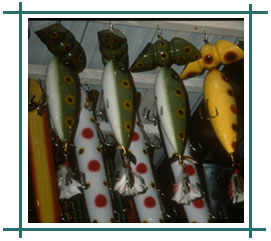 Giant lure made by Jack Swedburg, Burnett County, WI. Photo by Ruth Olson |
Weather Prediction Methods
Weather engulfs us. Its influence can be both dramatic and subtle. Weather tempers how we dress, how we live, the music we play, and the art we create. It can destroy our homes and threaten our lives. It affects our daily activities, leisure, holidays, transportation, commerce, agriculture, and nearly every aspect of our lives. Our fascination with the weather has led to 24-hour weather networks, feature-length motion pictures, and an explosion of detailed weather data over the Internet. Weather and its ever-changing nature has always drawn the attention of people and sometimes even alters their lives.
The atmosphere is very complicated, yet easily observable. People have always observed the atmosphere and have used their observations to explain atmospheric phenomena. Observing and then analyzing the atmosphere to gain an understanding is a scientific way of thinking. Peoples’ observations, explanations and understanding of the weather have naturally led to weather forecasts. Folklore forecasts are rooted in observations and passed down through the generations. While memorable, the folklore forecasts are of uneven quality—some good, others bad. This is just one method of forecasting the weather. Other methods include: Persistence, Climatological, Trend, Analog, and Numerical Weather Forecasts.
A persistence forecast is simple: the weather you are having now will be the weather you have later. The accuracy of this forecast is very dependent on where you are, the type of upper-troposphere winds that exist over your location, and how long a forecast you want. Low winds usually means a good persistence forecast.
A climatology forecast relies on the observation that weather for a particular day at a location doesn’t change much from one year to the next. As a result, a longterm average of weather on a certain day or month should be a good guess as to the weather for that day or month. An obvious climatology forecast for the Northern Hemisphere middle latitudes is, “Cold in December, warm in July.” You don’t need to be a meteorologist to make that forecast! The success of this forecast derives from the fact that weather, although changeable, is strongly determined by the tilt of the Earth and the global energy budget. Climatology forecasts can be quite specific. A favorite is the “White Christmas” forecast: What is the percent chance that at least one inch of snow will be on the ground at a particular location on December 25? This forecast depends on the past thirty years of weather observations on Christmas Day across the United States. It would change somewhat if more, fewer, or different years were used in the climatology.
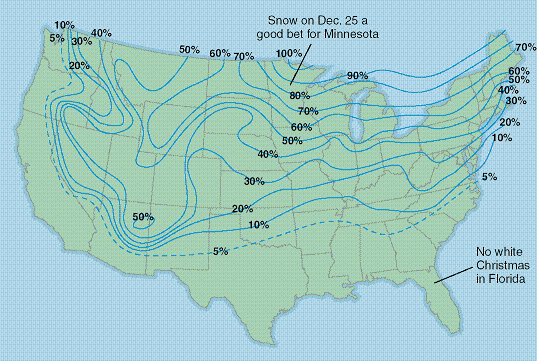
A trend forecast acknowledges that weather does change, but assumes that the weather-causing patterns, such as an extratropical cyclone, are themselves unchanging in speed, size, intensity, and direction of movement. Benjamin Franklin pioneered the concept of trend forecasting in 1743. Clouds ruined an eclipse for Ben in Philadelphia, but his brother in Boston saw the eclipse clearly. The clouds did not reach Boston until many hours later. Franklin discovered that “nor’easter” cyclones frequently moved up the East Coast, a trend that could be used to forecast the weather. Trend forecasts work quite well for a period of several hours. Forecasting for such a brief period is called "nowcasting." This is because large-scale weather systems such as cyclones don’t change very much over a short time period. Satellite observations are very useful in nowcasting.
The analog forecast acknowledges that weather changes, but unlike the trend method, it assumes that weather patterns can evolve with time. The key—and flawed—assumption for the analog forecast is that history repeats itself, meteorologically speaking. The analog forecaster’s task is to locate the date in history when the weather is a perfect match, or analog, to today’s weather. Then the forecast for tomorrow is simple: whatever happened in the day after the analog will be the weather for tomorrow. The forecast for the day after tomorrow is whatever happened in the second day after the analog, and so forth.
The technique of approximating tough real-world problems with numbers is called numerical modeling. The numerical formulas used are called a model, just as a realistic approximation of a train is called a “model railroad.” The weather forecasts you’ve grown up hearing are based on a small number of numerical models of the atmosphere. These models coordinate the essential work of performing millions of arithmetic calculations. They are converted from arithmetic formulas into complicated computer programs comprised of tens of thousands of lines of computer code. Most of today’s forecasts are based on predictions from numerical weather models.
Suggested Activities
Introducing Proverbs
Begin by telling a story of a proverb that is a part of your family’s tradition. Include in the story who usually says the proverb and what it means to your family. Ask students to name proverbs that they know. Have them give the same type of contextual information as you did: from whom did they learn these sayings; why do they remember it today? How do they use these sayings in their lives—do they look for a red sky the night before a softball game or a swimming trip?
After several proverbs have been named and recorded on the board, ask what the similarities are between these different proverbs (they give advice; they contain wisdom; they’re short; they’re easy to remember, etc.) Cull the main defining elements of proverbs from the discussion.
Class Discussion on Artistic Qualities of Proverbs
Return to the class-generated proverbs on the board. Ask the students to identify the vital narrative aspect of each proverb. Is it the rhyme, the imagery, the humor, the contrasts, or something else that make the proverb pithy?
Understanding the Proverb
Have your students read the “Wind from the West…” proverb carefully. Discuss what advice is being given in each line. Together produce a table referencing what each of the four component wind directions predicts about fishing conditions. The result should be similar to the following:
| Observed Wind Direction | Probable Fishing Conditions | North |
Poor, possibly dangerous |
South |
Excellent |
West |
Excellent |
East |
Poor |
|---|
Making PredictionsReview the Norwegian Model of the mid-latitude cyclone. According to the wind directions associated with the low pressure and fronts of this model, have your students predict where the fishing would be good, poor, and/or dangerous. Now let’s make this model more applicable to their lives! Given this weather scenario (shown below with fronts and the low pressure center), have your students choose which of the three Wisconsin lakes they would rather fish on. Which lake should be avoided for safety reasons? |
The Norwegian Cyclone Model A midlatitude cyclone composed of a cold front and a warm front extending to the south and the east, respectively, from a low-pressure center. Winds blow counter-clockwise around the cyclone. Click here for more information on the Norwegian Cyclone Model. |
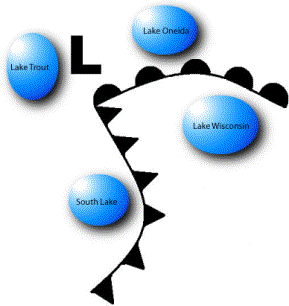 |
Interview a Fisherman
Have your students interview a member of their family or community who is an avid fisherman. Do these fishermen use any specific fishing proverbs? Do they have beliefs that link weather and fishing?
Invite your students to create a proverb based on the experiences of the fisherman, as explained in the interview.
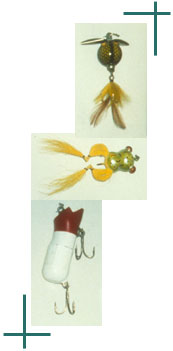 Various Wisconsin-made baits from Eau Claire, Stevens Point, Milwaukee, on display at the Northland Fishing Museum in Osseo, WI. Photo by Ruth Olson |
Analysis of Other Versions of the Proverb
Point out differences in different versions of the saying. Have students talk about why these different versions have come into existence. What has changed? How might identity differ from proverb to proverb?
Examples:
When the wind is from the south
the rain's in its mouth.The wind in the west
Suits everyone best.When the wind is blowing in the North
No fisherman should set forth,
When the wind is blowing in the East,
'Tis not fit for man nor beast,
When the wind is blowing in the South
It brings the food over the fish's mouth,
When the wind is blowing in the West,
That is when the fishing’s best!
Create Their Own!
Have your students write their own weather proverb based on their personal observations of weather signs—i.e. wind, clouds, temperature, rain, fog, rainbows, etc. Encourage your students to use literary techniques such as rhyme scheme, meter, alliteration, assonance, and consonance in order to sharpen their skills. Students can illustrate their weather proverbs and write a story in which a character from their own community uses the proverb.
Extension Activities
Analyze “Red Sky at Night” Proverb
Analyze the following proverb for the artistic and cultural qualities. Analyze why it holds true meteorologically.
Red sky at night, sailor’s delight;
Red sky at morning, sailors take warning.
This saying often yields a fairly accurate forecast. A clear western sky at sunset allows the sun to shine through the atmosphere, its light reddening due to Rayleigh scattering, which removes the blue colors from white light. The red colors then reflect off clouds in the eastern sky. Storm clouds to the east generally travel to the east under the influence of jet-stream winds. The reverse is true in the morning when the red sunlight shines on storm clouds approaching from the west, signaling the approach of a storm. However, this folklore doesn't work at all in overcast conditions, or at tropical latitudes where weather often moves from east to west.
On the Hunt for More Weather Proverbs
Have students ask their parents, neighbors, grandparents or friends if they know any weather proverbs. Ask students to write down any new weather proverbs that they hear. Students should be encouraged to talk to their informants about how they use proverbs. Lead a class discussion that brings out the common threads between different students’ experiences. This activity could be integrated with art by illustrating the proverbs.
Northeast, Northwest, Southeast and Southwest Winds?
As you and your students may have noticed, there is no mention in the proverb of such wind directions as Northeast and Southwest, etc. Have your students discuss what fishing conditions these wind directions could foster according to the logic of the saying and the Norwegian model. It may be useful to use the chart they created in the Understanding the Proverb activity above, adding on the four new wind directions. Next, have them make up a saying of their own that utilizes one or more of the directions not mentioned in the proverb.
Further Resources
Steven A. Ackerman and John A. Knox. 2003. Meteorology: Understanding the Atmosphere. CA: Brooks Cole.
George H. Schoemaker, ed. 1990. The Emergence of Folklore in Everyday Life: A Fieldguide and Sourcebook. Bloomington, IN: Trickster Press.
Jan Harold Brunvand. 1998. The Study of American Folklore: An Introduction (4th ed.) New York: Norton.
Mieder, Wolfgang. 1986. The Prentice-Hall Encyclopedia Of World Proverbs.
Russian Weather Proverbs an integrated lesson examining the science, art and culture behind Russian weather proverbs, from Moscow's Institute of New Technologies in Education.
Proverbs:At Home and Around the World is a lesson designed for grades 6-8 from the Read, Write, Think project.
Proverbs: More Than Words Say explores proverbs from around the world, with returned Peace Corps volunteers disucssing their meaning and use.
Standards and Benchmarks
| Grade 4 | Grade 8 | Grade 12 | |
|---|---|---|---|
| Language Arts: | A.4.1; A.4.2; A.4.3, A.4.4; B.4.1; C.4.2; D.4.2; E.4.1, F.4.1 | A.8.1; A.8.3; A.8.4; B.8.1; E.8.1; F.8.1 | A.12.1; A.12.4; B.12.1; C.12.2; E.12.1; F.12.1 |
| Social Studies: | A.4.1; A.4.2; A.4.7; B.4.1; B.4.8; E.4.11; E.4.13 | A.8.1; A.8.3; A.8.7; A.8.8; B.8.1; E.8.10; E.8.13 | A.12.2; A.12.11; E.12.13; E.12.14 |
| Science: | A.4.2, A.4.5 B.4.2 C.4.1, C.4.2, C.4.3, C.4.7, C.4.8, E.4.6, E.4.7 | A.8.4, A.8.6; B.8.4, B.8.5; C.8.1, C.8.2, C.8.7; E.8.1 | A.12.3, A.12.5; B.12.1, B.12.5; C.12.5, C.12.6 |
| Interpersonal and Leadership Skills: | J.4.7 J.4.8 | J.8.10 | |
| Career Development: | K.4.4 K.4.5 | K.8.9 |





